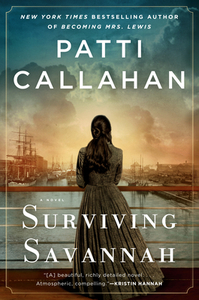Take a photo of a barcode or cover
Can’t stand the modern day story…DNF-ing without prejudice at chapter 5.
emotional
informative
slow-paced
Plot or Character Driven:
Character
Strong character development:
Yes
Loveable characters:
Complicated
Diverse cast of characters:
Yes
Flaws of characters a main focus:
Yes
In June of 1838, the luxury steamship Pulaski set sail from Charleston for what was to be an overnight journey to Baltimore. The ship never reached its destination: at just before midnight, a boiler explosion cast the Pulaski to the bottom of the Atlantic Ocean, taking many of its passengers with it. Nearly two hundred years later, the wreckage has been discovered off the Carolina coast, and Savannah history professor Everly Winthrop has been asked to guest-curate a museum collection featuring artifacts from the wreck.
Everly is no stranger to tragedy, having lost her best friend in a horrific accident just one year earlier. For Everly, life has become devoid of all meaning as she grieves her friend’s death and wonders why she, Everly, was given a second chance at life while her friend was not so fortunate. Seeking purpose as well as answers to some of life’s biggest questions, Everly buries herself in her research, focusing on two women known to have been onboard the Pulaski: Augusta Longstreet, one of the few who survived the wreckage, and her niece Lily, who along with her child and wet-nurse is thought to have been lost at sea. In Lily and Augusta, Everly discovers examples of courage and resilience, and through their stories she begins to uncover similar strengths within herself.
The novel—based on the historical Pulaski sinking (known as “The Titanic of the South”)—is told through alternating timelines and from the perspectives of Everly, Augusta, and Lilly. Each woman’s story is marked by suffering but also carries hope and a unique framing of the survival theme. I found something to admire in all three women, particularly in the lessons they glean from their experiences and the ways they change and move on after tragedy. Through Augusta, Everly, and Lilly we see differing reactions to trauma, all quite believable. These three women’s manifestations of “surviving the surviving” (through tears, determination, fumbling, and graciousness) are extremely different, painting a nuanced picture of the post-traumatic experience that is helpfully juxtaposed against the journeys of characters whose trauma reactions are far less healthy.
I was unfamiliar with this historical event and found the descriptions of the Pulaski and its sinking fascinating. I wish more page time had been dedicated to the ship itself and specifically to its sinking; instead, the story focuses more on the aftermath and, of course, on the uncovering of the wreckage decades later. But while the historical parts of the novel were, for me, the highlight, I appreciated Callahan’s clever interweaving of past and present, and her examination of how one’s existence is unequivocally connected to (but not dictated by) one’s past. In the novel (as with life, I’m sure Callahan would argue), the present-day story shapes the historical one, imbuing it with meaning and context and allowing the reader to make more clear sense of issues that remained clouded at the time.
Other than the story of the Titanic, I have never given much thought to life aboard a ship, particularly a historical one, nor have I thought much about the experience of uncovering a wreck and all that might entail. I loved being introduced to the topics through this book. But as intriguing as the Pulaski story is, I was even more drawn to the discussions of the time period in general (especially the portrayal of slavery, womanhood, and life among the southern elite in the early 1800s) as well as to the book’s poignant themes of survival, the quest for answers, a desire for justice, the cultivation of empathy, an understanding of fate, and the impact of generational stories. Callahan draws some powerful conclusions about the nature of grief and the roles both choice and fate play in the survival experience.
I do think the story would have been better served by a shade more opaqueness regarding these themes: Callahan does quite a bit of spelling out of both the history (which at times reads too textbook/pedantic) and the lessons learned by our story’s characters; I wish she had trusted her reader more and moralized less. I also would have enjoyed the reading experience more if the book had been about thirty percent shorter (possibly by ramping up the mystery component and toning down the romantic elements, which are sweet but distracting). Still, this is a remarkable story and I am so glad that Callahan has brought it to the page. For fans of history, be sure not to miss the detailed Author’s note and research included at the back of the book!
My Rating: 4 Stars.
This review first appeared on my personal blog:
Please visit my site for more book reviews: https://kendranicole.net/category/book-corner/
emotional
tense
Surviving Savannah by Patti Callahan is a 2021 Berkley publication.
1838-
An exciting voyage on the Pulaski steamship, suddenly turns into a nightmarish tragedy. On board the ship, are Lilly and Augusta, two women trapped by their societal obligations and expectations.
Thrown into a life or death situation, the women come to a point of reckoning… yet only one of them would make it home to Savannah..
One hundred and eighty years later, the discovery of the sunken Pulaski steamship, once dubbed the ‘Titanic of the South’, gives Everly Winthrop, a professor, a chance to curate the Pulaski exhibit for a museum, providing her with a much needed lifeline.
Since the loss of her best friend, Everly's been riddled with guilt, going through the motions of life, unable to pull herself out a deep depression. As a museum curator, Everly dives into the history of the Pulaski- both figuratively and literally.
I loved the premise of this novel and of course the setting. Savannah is such a storied location the city nearly always steals the show.
I have learned, by now, that when dealing with a dual timeline story, the historical elements are the heart and soul of the novel, nearly always overpowering the contemporary elements in terms of depth.
This book is no exception to that rule, although, I felt the historical portions were not as frequent or fleshed out, as I would have liked.
The author obviously did her homework, though, creating a very vivid picture of the ship, the horrifying disaster, and the struggle for survival.
The mystery of the Pulaski is so interesting it easily makes Lilly and Augusta’s part of the story the most heartbreaking, compelling, revealing, and riveting!
That said, it would have been incredibly hard for Everly to compete with that level of intensity, but her research is what helps to bring the history alive in her contemporary setting.
Still, Everly’s emotions were often palpable, beginning with the heaviness of her spirit, then progressing to her slow building excitement about the museum project, which leads to her eventual reawakening to life and living, which was a wonderful transformation to witness. I loved the way the past blended into the present and was a source of inspiration to Everly.
The book also takes a look at how people cope with what comes after, once they've managed to survive something monumental, still living, seemingly by fate, when others do not. It is a thought provoking topic, as not everyone who survives will go on to live productive or exemplary lives.
Overall, this was just the kind of historical fiction I have been craving. I learned something about a historical event I was not familiar with, and the storyline gave me some psychological elements to chew on. It is always nice to feel one has learned something new. It seems to me that the Pulaski steamship doesn't pop up in historical fiction too often- if ever, which is part of the reason it captivated me, I'm sure. I also really liked the characters, and watching them develop as a fascinating, historical mystery unfolded.
Overall, this was an interesting, memorable and lovely story, all around.
4 stars
1838-
An exciting voyage on the Pulaski steamship, suddenly turns into a nightmarish tragedy. On board the ship, are Lilly and Augusta, two women trapped by their societal obligations and expectations.
Thrown into a life or death situation, the women come to a point of reckoning… yet only one of them would make it home to Savannah..
One hundred and eighty years later, the discovery of the sunken Pulaski steamship, once dubbed the ‘Titanic of the South’, gives Everly Winthrop, a professor, a chance to curate the Pulaski exhibit for a museum, providing her with a much needed lifeline.
Since the loss of her best friend, Everly's been riddled with guilt, going through the motions of life, unable to pull herself out a deep depression. As a museum curator, Everly dives into the history of the Pulaski- both figuratively and literally.
I loved the premise of this novel and of course the setting. Savannah is such a storied location the city nearly always steals the show.
I have learned, by now, that when dealing with a dual timeline story, the historical elements are the heart and soul of the novel, nearly always overpowering the contemporary elements in terms of depth.
This book is no exception to that rule, although, I felt the historical portions were not as frequent or fleshed out, as I would have liked.
The author obviously did her homework, though, creating a very vivid picture of the ship, the horrifying disaster, and the struggle for survival.
The mystery of the Pulaski is so interesting it easily makes Lilly and Augusta’s part of the story the most heartbreaking, compelling, revealing, and riveting!
That said, it would have been incredibly hard for Everly to compete with that level of intensity, but her research is what helps to bring the history alive in her contemporary setting.
Still, Everly’s emotions were often palpable, beginning with the heaviness of her spirit, then progressing to her slow building excitement about the museum project, which leads to her eventual reawakening to life and living, which was a wonderful transformation to witness. I loved the way the past blended into the present and was a source of inspiration to Everly.
The book also takes a look at how people cope with what comes after, once they've managed to survive something monumental, still living, seemingly by fate, when others do not. It is a thought provoking topic, as not everyone who survives will go on to live productive or exemplary lives.
Overall, this was just the kind of historical fiction I have been craving. I learned something about a historical event I was not familiar with, and the storyline gave me some psychological elements to chew on. It is always nice to feel one has learned something new. It seems to me that the Pulaski steamship doesn't pop up in historical fiction too often- if ever, which is part of the reason it captivated me, I'm sure. I also really liked the characters, and watching them develop as a fascinating, historical mystery unfolded.
Overall, this was an interesting, memorable and lovely story, all around.
4 stars
In 1838, the steamship Pulaski which set sail from Savannah with many of the city’s prominent citizens on board, sank after a boiler exploded. Nearly everyone in town was affected by the tragedy but as time passed, details of the event faded from memory. In this well-researched and dramatic historical novel, Patti Callahan documents the harrowing events experienced by the passengers.
Everly Winthrop grew up with her grandfather spinning tales about the Pulaski, a steamship memorialized in a painting hanging in the family home. He always mentioned Lily Forsyth, lost at sea, whose statue commemorated all those lost when the boat sank.
Now a history professor at Savannah’s famed SCAD, Everly is in grieving and has pulled back from all her friends. When Oliver Samford approaches her to guest curate a show at his museum, he tempts her with the news that the remains of the Pulaski have been found. Although Everly had resolved to stay away from Oliver, her curiosity was too strong to say no to the chance to find out what really happened to Lily.
Everly’s investigation revealed that Lily was only one of Eleven members of her family on the boat’s fateful voyage. Her aunt and best friend, a known survivor, Augusta Longstreet, was also on board.
Surviving Savannah unfurls with dual timelines from three perspectives—Everly’s, Lily’s, and Augusta’s. I particularly liked the past timelines. Callahan was meticulous recreating the ship’s milieux, and her description of the sinking and it’s aftermath were vivid and compelling—with some images absolutely haunting! I can’t think of a better depiction of shipwreck.
Callahan also addresses issues of race and gender roles and shows the privileged status of white men, at least before trauma becomes somewhat of an equalizer.
Everly’s sections provided necessary context for the events of the past, and her own traumatic event was used to link her to the historical women. Both Augusta and Everly suffered survivor’s guilt and wrestled with the idea of fate and why they were chosen to live. This is a rich and important theme, but presented too heavy-handedly and repetitively for my taste.
In a way, the timelines coalesce in Everly’s triumphant exhibit which is organized in a compelling and intense manner. The author’s note provides interesting information about her process and should not be skipped!
Historical fiction lovers should give this title a look! It’ll be of special interest to those who like reading about pre-Civil War southern culture.
Thank you to NetGalley, Berkley, and the #BerkleyWritesStrongWomen #BerkleyBuddyReads for an advance reading copy in exchange for an honest review.
Everly Winthrop grew up with her grandfather spinning tales about the Pulaski, a steamship memorialized in a painting hanging in the family home. He always mentioned Lily Forsyth, lost at sea, whose statue commemorated all those lost when the boat sank.
Now a history professor at Savannah’s famed SCAD, Everly is in grieving and has pulled back from all her friends. When Oliver Samford approaches her to guest curate a show at his museum, he tempts her with the news that the remains of the Pulaski have been found. Although Everly had resolved to stay away from Oliver, her curiosity was too strong to say no to the chance to find out what really happened to Lily.
Everly’s investigation revealed that Lily was only one of Eleven members of her family on the boat’s fateful voyage. Her aunt and best friend, a known survivor, Augusta Longstreet, was also on board.
Surviving Savannah unfurls with dual timelines from three perspectives—Everly’s, Lily’s, and Augusta’s. I particularly liked the past timelines. Callahan was meticulous recreating the ship’s milieux, and her description of the sinking and it’s aftermath were vivid and compelling—with some images absolutely haunting! I can’t think of a better depiction of shipwreck.
Callahan also addresses issues of race and gender roles and shows the privileged status of white men, at least before trauma becomes somewhat of an equalizer.
Everly’s sections provided necessary context for the events of the past, and her own traumatic event was used to link her to the historical women. Both Augusta and Everly suffered survivor’s guilt and wrestled with the idea of fate and why they were chosen to live. This is a rich and important theme, but presented too heavy-handedly and repetitively for my taste.
In a way, the timelines coalesce in Everly’s triumphant exhibit which is organized in a compelling and intense manner. The author’s note provides interesting information about her process and should not be skipped!
Historical fiction lovers should give this title a look! It’ll be of special interest to those who like reading about pre-Civil War southern culture.
Thank you to NetGalley, Berkley, and the #BerkleyWritesStrongWomen #BerkleyBuddyReads for an advance reading copy in exchange for an honest review.
This is an engrossing story of the survivors of the Pulaski ship wreck. Patti Callahan does a wonderful job weaving facts with storytelling.
Her podcast The Untold Story Behind Surviving Savannah and her virtual author events allow one to fully immerse one’s self into the story and the people.
Her podcast The Untold Story Behind Surviving Savannah and her virtual author events allow one to fully immerse one’s self into the story and the people.
I often leave stars for my reviews but rarely write an actual review. However, this book is one that touched me to the core. Learning about the lives of the people that survived this terrible tragedy and how they survived was inspiring. Realizing that how we survive tragedy and what we deal with it afterwards shows who we truly are brought tears to my cheeks. I would gladly give this book more than five stars if I could
challenging
emotional
inspiring
reflective
sad
medium-paced
Plot or Character Driven:
A mix
Strong character development:
Yes
Loveable characters:
Complicated
Diverse cast of characters:
Yes
Flaws of characters a main focus:
Complicated





